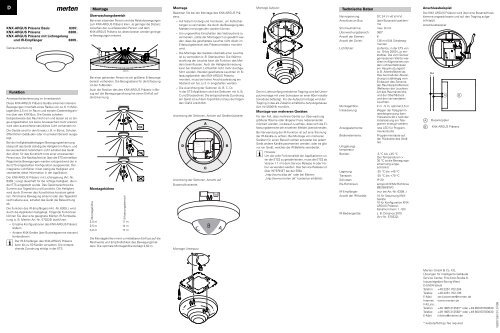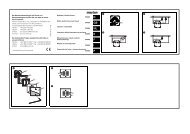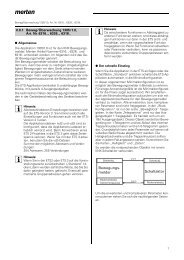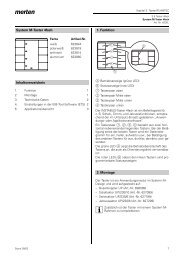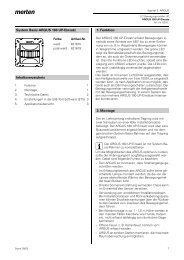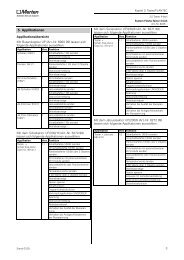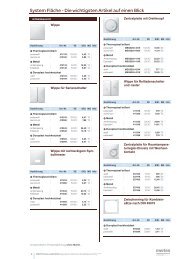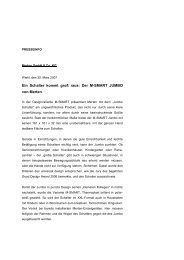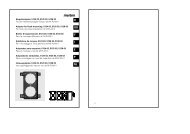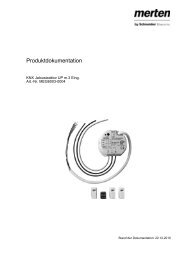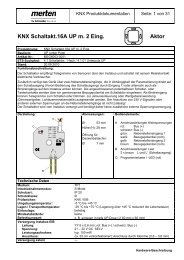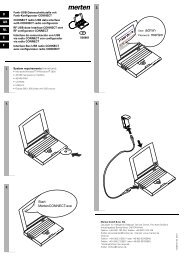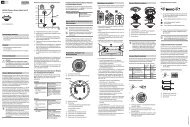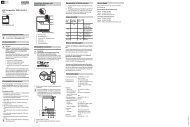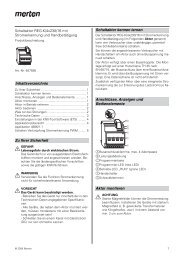6307xx/6308xx/6309xx KNX ARGUS Präsenz
6307xx/6308xx/6309xx KNX ARGUS Präsenz
6307xx/6308xx/6309xx KNX ARGUS Präsenz
Erfolgreiche ePaper selbst erstellen
Machen Sie aus Ihren PDF Publikationen ein blätterbares Flipbook mit unserer einzigartigen Google optimierten e-Paper Software.
D<br />
<strong>KNX</strong>-<strong>ARGUS</strong> <strong>Präsenz</strong> Basic 6307..<br />
<strong>KNX</strong>-<strong>ARGUS</strong> <strong>Präsenz</strong> 6308..<br />
<strong>KNX</strong>-<strong>ARGUS</strong> <strong>Präsenz</strong> mit Lichregelung<br />
und IR-Empfänger 6309..<br />
Gebrauchsanleitung<br />
Funktion<br />
Anwesenheitserkennung im Innenbereich.<br />
Diese <strong>KNX</strong>-<strong>ARGUS</strong> <strong>Präsenz</strong>-Geräte erkennen kleinere<br />
Bewegungen innerhalb eines Radius von ca. 6 m (Montagehöhe<br />
2,5 m) im Raum und senden Datentelegramme<br />
über den <strong>KNX</strong>-Bus. Die Geräte schalten<br />
beispielsweise das Raumlicht ein und lassen es so lange<br />
eingeschaltet, bis keine Anwesenheit mehr erkannt<br />
wird oder ausreichend natürliches Licht vorhanden ist.<br />
Die Geräte sind für den Einsatz z. B. in Büros, Schulen,<br />
öffentlichen Gebäuden oder im privaten Bereich ausgelegt.<br />
Bei der helligkeitsabhängigen Bewegungserkennung<br />
überprüft das Gerät ständig die Helligkeit im Raum, und<br />
bei ausreichend natürlichem Licht schaltet das Gerät<br />
den Aktor für das Kunstlicht trotz einer anwesenden<br />
Person aus. Die Nachlaufzeit ist über die ETS einstellbar.<br />
Registrierte Bewegungen werden entsprechend der in<br />
der ETS eingestellten Konfiguration ausgewertet. Der<br />
integrierte Lichtfühler misst stetig die Helligkeit und<br />
verarbeitet diese Information in der Applikation.<br />
Der <strong>KNX</strong>-<strong>ARGUS</strong> <strong>Präsenz</strong> mit Lichtregelung (Art.-Nr.<br />
6309..) sorgt dauerhaft für die richtige Helligkeit, die in<br />
der ETS eingestellt wurde. Das Gerät berechnet die<br />
Summe aus Tageslicht und Kunstlicht. Die Helligkeit<br />
wird durch Dimmen des Kunstlichtes konstant gehalten.<br />
Wird keine Bewegung erkannt oder das Tageslicht<br />
reicht alleine aus, schaltet das Gerät die Beleuchtung<br />
ab.<br />
Die Funktion des IR-Empfängers (Art.-Nr. 6309..) wird<br />
durch die Applikation festgelegt. Folgende Funktionen<br />
können Sie über eine geeignete Merten IR-Fernbedienung<br />
(z. B. Merten Art.-Nr. 570222) ausführen:<br />
– Einzelne Konfigurationen des <strong>KNX</strong>-<strong>ARGUS</strong> <strong>Präsenz</strong><br />
ändern.<br />
– Andere <strong>KNX</strong>-Geräte über Bustelegramme steuern/<br />
fernbedienen.<br />
| Der IR-Empfänger des <strong>KNX</strong>-<strong>ARGUS</strong> <strong>Präsenz</strong><br />
kann bis zu 50 Kanäle verwalten. Die entsprechende<br />
Zuordnung erfolgt in der ETS.<br />
Montage<br />
Überwachungsbereich<br />
Bei einer sitzenden Person sind die Relativbewegungen<br />
zum <strong>KNX</strong>-<strong>ARGUS</strong> <strong>Präsenz</strong> klein. Je geringer die Distanz<br />
zwischen der zu erfassenden Person und dem<br />
<strong>KNX</strong>-<strong>ARGUS</strong> <strong>Präsenz</strong> ist, desto besser werden geringere<br />
Bewegungen erkannt.<br />
Bei einer gehenden Person ist ein größerer Erfassungsbereich<br />
vorhanden. Die Bezugsebene für die Erfassung<br />
ist der Fußboden.<br />
Auch die Position des des <strong>KNX</strong>-<strong>ARGUS</strong> <strong>Präsenz</strong> in Bezug<br />
auf die Bewegungsrichtung hat einen Einfluß auf<br />
die Erkennung.<br />
Montagehöhen<br />
Montagehöhe<br />
2,5 m<br />
14,0 m<br />
Erfassungsbereich<br />
2,0 m 11 m<br />
2,5 m 14 m<br />
3,0 m 17 m<br />
OK<br />
OK<br />
OK<br />
Die Montagehöhe nimmt unmittelbaren Einfluss auf die<br />
Reichweite und Empfindlichkeit des Bewegungsmelders.<br />
Die optimale Montagehöhe beträgt 2,50 m.<br />
Montage<br />
Beachten Sie bei der Montage des <strong>KNX</strong>-<strong>ARGUS</strong> <strong>Präsenz</strong>:<br />
– Auf festem Untergrund montieren, um Fehlschaltungen<br />
zu vermeiden, die durch die Bewegung des<br />
Melders hervorgerufen werden können.<br />
– Um ungewolltes Einschalten des Verbrauchers zu<br />
vermeiden, sollte der Montageort so gewählt werden,<br />
dass die geschaltete Leuchte nicht direkt im<br />
Erfassungsbereich des <strong>Präsenz</strong>melders montiert<br />
wird.<br />
– Die Montage des Gerätes oberhalb einer Leuchte<br />
ist zu vermeiden (z. B. Stehleuchte). Die Wärmestrahlung<br />
der Leuchte kann die Funktion des Melders<br />
beeinflussen. Auch die Helligkeitsmessung<br />
kann bei direktem Lichteinfall nicht mehr durchgeführt<br />
werden. Werden geschaltete Leuchten im Erfassungsbereich<br />
des <strong>KNX</strong>-<strong>ARGUS</strong> <strong>Präsenz</strong><br />
montiert, muss bei hoher Anschlussleistung ein<br />
Abstand von bis zu 3 m eingehalten werden.<br />
– Die Ausrichtung der Sektoren (A, B, C, D).<br />
In der ETS-Applikation sind die Sektoren mit A, B,<br />
C und D bezeichnet. Die entsprechende Zuordnung<br />
am Gerät ist auf dem Typschild und aus der folgenden<br />
Grafik ersichtlich.<br />
Anordnung der Sektoren, Ansicht auf Geräterückseite:<br />
D<br />
instabus<br />
Merten<br />
<strong>ARGUS</strong> Présence<br />
Anordnung der Sektoren, Ansicht auf<br />
Busanschlussseite:<br />
C<br />
Montage Unterputz:<br />
A<br />
C<br />
B<br />
B A<br />
B<br />
Montage Aufputz:<br />
Der im Lieferumfang enthaltene Tragring wird bei Unterputzmontage<br />
mit zwei Schrauben an einer 60er Installationsdose<br />
befestigt. Für die Aufputzmontage wird der<br />
Tragring in das als Zubehör erhältliche Aufputzgehäuse<br />
(Art.-Nr 550619) montiert.<br />
Montage von mehreren Geräten:<br />
Für den Fall, dass mehrere Geräte zur Überwachung<br />
größerer Räume oder längerer Flure nebeneinander<br />
montiert werden, ist darauf zu achten, dass sich die Erfassungsbereiche<br />
der einzelnen Melder überschneiden.<br />
Bei Verwendung der IR-Funktion ist auf eine Trennung<br />
der IR-Kanäle zu achten. Bei Montage von mehreren<br />
Geräten für einen Bereich sollten entweder bei jedem<br />
Gerät andere Kanäle parametriert werden, oder es gibt<br />
nur ein Gerät, welches die IR-Befehle verarbeitet.<br />
| Hinweis:<br />
Um die volle Funktionalität der Applikationen unter<br />
der ETS2 zu gewährleisten, muss die ETS2 ab<br />
Version 1.1 mit dem Service Release A oder höher<br />
verwendet werden. Das Service Release ist<br />
über INTERNET bei der EIBA<br />
„http://www.eiba.de“ oder bei Merten<br />
„http://www.merten.de” kostenlos erhältlich.<br />
Technische Daten<br />
Nennspannung: DC 24 V (+6 V/-4 V)<br />
Anschluss an Bus: über Busanschlussklemme<br />
Stromaufnahme: max. 8 mA<br />
Überwachungsbereich: 360°<br />
Anzahl der Ebenen: 6<br />
Anzahl der Zonen: 136 mit 544 Schaltsegmenten<br />
Lichtfühler: stufenlos, in der ETS von<br />
ca. 10 bis 2000 Lux einstellbar.<br />
Die vom Sensor<br />
gemessenen Werte weichen<br />
im Allgemeinen von<br />
den Lichtverhältnissen<br />
am Hauptnutzungsort<br />
(z.B. Arbeitsfläche) ab.<br />
Das Ausmaß der Abweichung<br />
ist abhängig vom<br />
Einbauort des Sensors,<br />
der Raumbeschaffenheit<br />
(Reflexion der Leuchten,<br />
Art des Raumanstrichs<br />
und der Oberflächen)<br />
und den verwendeten<br />
Leuchten.<br />
Montagehöhe: 2 m - 5 m, optimal 2,5 m<br />
Initialisierung: Wegen der Telegrammratenbegrenzung<br />
kann<br />
frühestens 20 s nach der<br />
Initialisierung ein Telegramm<br />
erzeugt werden.<br />
Anzeigeelemente: rote LED für Programmierkontrolle<br />
Bedienelemente: Programmiertaste auf<br />
der Rückseite des Gerätes<br />
Umgebungs<br />
temperatur<br />
Betrieb: -5 °C bis +45 °C<br />
(bei Temperaturen ><br />
30 °C ist die Bewegungserkennungeingeschränkt)<br />
Lagerung: -25 °C bis +45 °C<br />
Transport: -25 °C bis +70 °C<br />
Schutzart: IP 20<br />
EG-Richtlinien: entspricht EMV-Richtlinie<br />
89/336/EWG<br />
IR-Empfänger: (nur bei Art.-Nr. 6309..)<br />
Anzahl der IR-Kanäle: 10 für Steuerung <strong>KNX</strong>-<br />
Geräte<br />
10 für Konfiguration <strong>KNX</strong>-<br />
<strong>ARGUS</strong> <strong>Präsenz</strong>;<br />
Kanalnummern 1 - 50)<br />
IR-Bediengeräte: z. B. Distance 2010<br />
(Art.-Nr. 570222).<br />
Anschlussbeispiel:<br />
Der <strong>KNX</strong> <strong>ARGUS</strong> <strong>Präsenz</strong> wird über eine Busanschlussklemme<br />
angeschlossen und auf den Tragring aufgeschnappt.<br />
Anschlussbeispiel:<br />
Bus<br />
+ -<br />
instabus<br />
Merten<br />
<strong>ARGUS</strong> PrØsence<br />
pour la programmation<br />
Poussoir<br />
B<br />
L<br />
T<br />
A B<br />
A Busankoppler<br />
B <strong>KNX</strong> <strong>ARGUS</strong> <strong>Präsenz</strong><br />
Merten GmbH & Co. KG,<br />
Lösungen für intelligente Gebäude<br />
Service Center, Fritz-Kotz-Straße 8,<br />
Industriegebiet Bomig-West<br />
D-51674 Wiehl<br />
Telefon: +49 2261 702-204<br />
Telefax: +49 2261 702-136<br />
E-Mail: servicecenter@merten.de<br />
Internet: www.merten.de<br />
InfoLine:<br />
Telefon: +49 1805 212581* oder +49 800 63783640<br />
Telefax: +49 1805 212582* oder +49 800 63783630<br />
E-Mail: infoline@merten.de<br />
* kostenpflichtig / fee required<br />
V6307-581-01 01/08
GB<br />
<strong>KNX</strong> <strong>ARGUS</strong> Presence Basic 6307..<br />
<strong>KNX</strong> <strong>ARGUS</strong> Presence 6308..<br />
<strong>KNX</strong> <strong>ARGUS</strong> Presence with<br />
lighting control and IR receiver 6309..<br />
Operating instructions<br />
Function<br />
Indoor presence detection.<br />
The <strong>KNX</strong> <strong>ARGUS</strong> Presence devices detect small<br />
movements within a radius of approx.6 m (mounting<br />
height 2.5 m) in the room and send data telegrams via<br />
the <strong>KNX</strong> bus. The devices switch the light on in the<br />
room for example and leave it switched on until<br />
presence is no longer detected or there is sufficient<br />
natural light.<br />
The devices can be used, for example, in offices,<br />
schools, public buildings or at home.<br />
In the case of brightness-dependent movement<br />
detection, the device continually checks the brightness<br />
level in the room and when there is sufficient natural<br />
light, the device switches off the actuator for artificial<br />
lighting, despite the room being occupied. The<br />
overshoot time can be adjusted using the ETS.<br />
Registered movements are evaluated via the<br />
configuration set in ETS. The integrated light sensor<br />
continually measures the brightness level and<br />
processes this information in the application.<br />
The <strong>KNX</strong> <strong>ARGUS</strong> Presence with lighting control (art. no.<br />
6309..) continually ensures the correct brightness<br />
which is set in ETS. The device calculates the total of<br />
daylight and artificial light. The brightness is maintained<br />
at a constant by dimming the artificial light. If no<br />
movements are detected or the daylight alone is<br />
sufficient, the device switches the lighting off.<br />
The function of the IR receiver (art. no. 6309..) is<br />
defined by the application. The following functions can<br />
be carried out with a suitable Merten IR remote control<br />
(e.g. Merten art. no. 570222).<br />
– Change individual configurations of the <strong>KNX</strong><br />
<strong>ARGUS</strong> Presence.<br />
– (Remotely) control other <strong>KNX</strong> devices via bus<br />
telegrams.<br />
| The IR receiver of the <strong>KNX</strong> <strong>ARGUS</strong> Presence can<br />
manage up to 50 channels. The corresponding<br />
assignment is made in the ETS.<br />
Installation<br />
Area of detection<br />
The relative movements of a seated person appear<br />
small to the <strong>KNX</strong> <strong>ARGUS</strong> Presence. The shorter the<br />
distance between the detected person and the <strong>KNX</strong><br />
<strong>ARGUS</strong> Presence, the better smaller movements are<br />
detected.<br />
When a person is walking, a larger area of detection is<br />
available. The reference level for detection is the floor.<br />
Also the position of the <strong>KNX</strong> <strong>ARGUS</strong> Presence in relation<br />
to the moving direction influences the detection.<br />
Mounting heights<br />
Mounting height<br />
2,5 m<br />
14,0 m<br />
detection area<br />
2.0 m 11 m<br />
2.5 m 14 m<br />
3.0 m 17 m<br />
OK<br />
OK<br />
OK<br />
The mounting height has a direct effect on the range<br />
and sensitivity of the movement detector. The optimum<br />
mounting height is 2.50 m.<br />
Installation<br />
Observe the following when installing the <strong>KNX</strong> <strong>ARGUS</strong><br />
Presence:<br />
– Mount on a fixed base to avoid maloperations<br />
which can be caused by the movement of the<br />
detector.<br />
– To prevent the load from being switched on<br />
unnecessarily, the installation site should be<br />
selected so that the switched luminaire is not<br />
directly mounted in the area of detection of the<br />
presence detector.<br />
– The installation of the device above a luminaire<br />
should be avoided (e.g. standard lamp). The heat<br />
radiation of the luminaire can influence the function<br />
of the detector. The brightness measurement can<br />
also no longer be carried out when there is a direct<br />
light incidence. If switched luminaires are mounted<br />
in the area of detection of the <strong>KNX</strong> <strong>ARGUS</strong><br />
Presence, a distance of up to 3 m must be<br />
maintained at a high connected load.<br />
– The alignment of sectors (A, B, C, D).<br />
The sectors are marked with A, B, C and D in the<br />
ETS applications. The corresponding alignment of<br />
the device can be seen on the type label and in the<br />
following graphic.<br />
Alignment of the sectors; rear view of the device<br />
D<br />
instabus<br />
Merten<br />
<strong>ARGUS</strong> Présence<br />
A<br />
C<br />
Alignment of the sectors; view of the bus connection<br />
side<br />
C<br />
Flush-mounted installation:<br />
B<br />
B A<br />
B<br />
Surface-mounted installation:<br />
For flush-mounted installation, the retaining ring<br />
included with supply is fixed with two screws to a size<br />
60 installation box. For surface mounting, the retaining<br />
ring is mounted in the surface-mounted housing (art.<br />
no. 550619) which is available as an accessory.<br />
Installation of several devices:<br />
In the event that several devices are mounted next to<br />
each other to monitor larger rooms or longer corridors,<br />
it should be ensured that the areas of detection of the<br />
individual detectors overlap.<br />
When using the IR function, a separation of the IR<br />
channels must be noted. When installing several<br />
devices in one area, either a different channel should be<br />
parameterised for each device or there may only be one<br />
central device which processes the IR commands.<br />
| Note:<br />
To guarantee the full functionality of the<br />
application under ETS2, it is necessary to use<br />
ETS2 from version 1.1 onwards with Service<br />
Release A or higher. Service Release is available<br />
at no cost to you at<br />
“http://www.eiba.de” or at<br />
“http://www.merten.de”.<br />
Technical data<br />
Nominal voltage: DC 24 V (+6 V/-4 V)<br />
Connection to the bus: via bus connecting<br />
terminal<br />
Current consumption: max. 8 mA<br />
Area of detection: 360°<br />
Number of levels: 6<br />
Number of zones: 136 with 544 switching<br />
segments<br />
Light sensor: infinitely adjustable in<br />
ETS between approx. 10<br />
and 2000 lux. The values<br />
measured by the sensor<br />
deviate in general from<br />
the lighting conditions at<br />
the main place of usage<br />
(e.g. work surface). The<br />
extent of the deviation is<br />
dependent on the<br />
installation site of the<br />
sensor, the properties of<br />
the room (reflection of<br />
the luminaires, type of<br />
paint on the walls and<br />
the surfaces) and the<br />
luminaires used.<br />
Mounting height: 2 m - 5 m, optimum 2.5<br />
m<br />
Initialisation: Due to the limitation of<br />
the telegram rate, a<br />
telegram cannot be<br />
generated until at least<br />
20 sec. after the<br />
initialisation.<br />
Display elements: red LED for checking the<br />
programming<br />
Operating elements: Programming button on<br />
the rear of the device<br />
Ambient<br />
temperature<br />
Operation: -5°C to +45°C<br />
(at temperatures > 30°C,<br />
the movement detection<br />
is limited)<br />
Storage: -25°C to +45°C<br />
Transport: -25°C to +70°C<br />
Type of protection: IP 20<br />
EC guidelines: complies with EMC<br />
guideline 89/336/EEC<br />
IR receiver: (only for art. no. 6309..)<br />
Number of IR channels: 10 for controlling <strong>KNX</strong><br />
devices<br />
10 for configuring <strong>KNX</strong><br />
<strong>ARGUS</strong> Presence;<br />
channel no. 1 - 50<br />
IR operating units: e.g. Distance 2010<br />
(art. no. 570222).<br />
Connection example:<br />
The <strong>KNX</strong> <strong>ARGUS</strong> Presence is connected via a bus<br />
connecting terminal and snapped onto the retaining<br />
ring.<br />
Connection example:<br />
Bus<br />
+ -<br />
instabus<br />
Merten<br />
<strong>ARGUS</strong> PrØsence<br />
pour la programmation<br />
Poussoir<br />
B<br />
L<br />
T<br />
A B<br />
A Bus coupler<br />
B <strong>KNX</strong> <strong>ARGUS</strong> Presence


